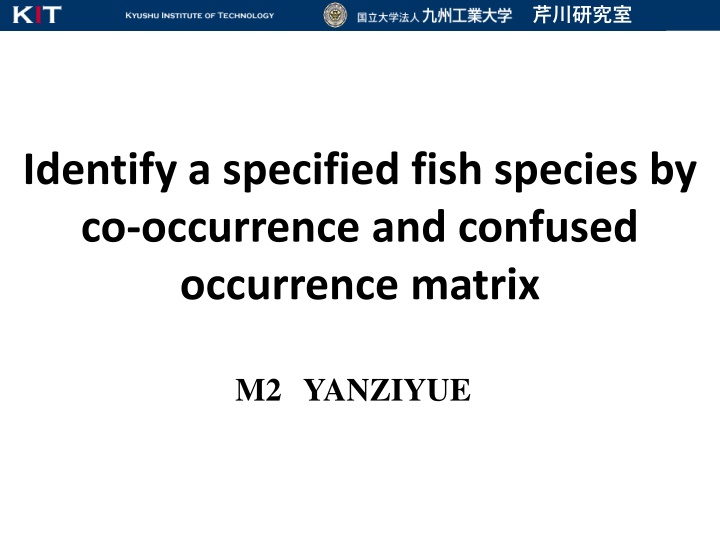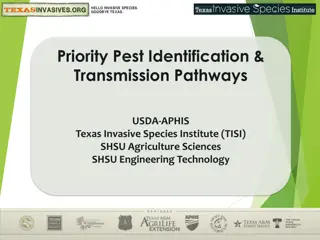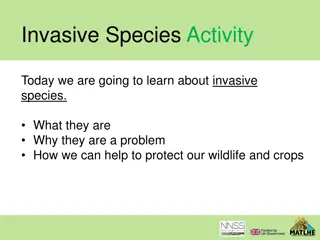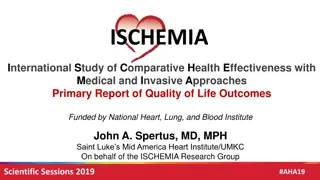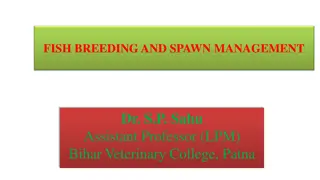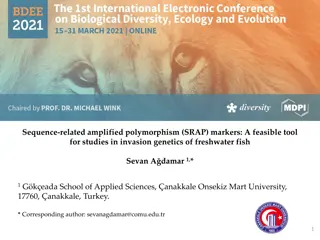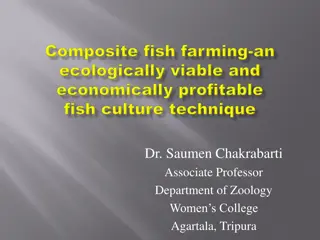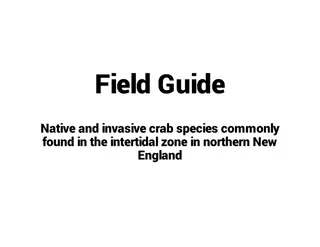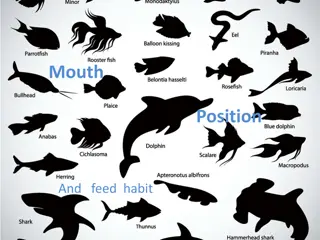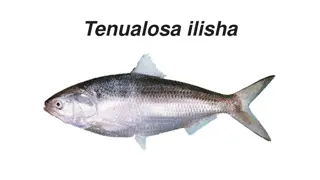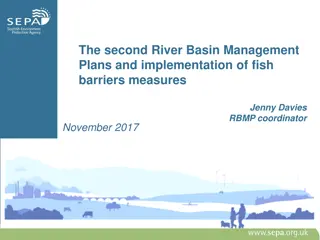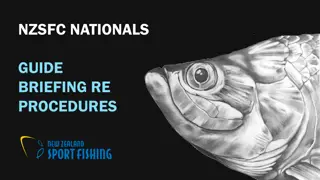Protecting Native Species from Invasive Alien Fish
Invasive alien fish species threaten the ecological balance by outcompeting native species. This work focuses on identifying and protecting native fish using statistical evaluation parameters and co-occurrence matrices. Images of three fish species - carp, sunfish, and black bass - are collected and analyzed to determine their characteristics. The goal is to safeguard the ecosystem from the negative impacts of invasive species.
Download Presentation

Please find below an Image/Link to download the presentation.
The content on the website is provided AS IS for your information and personal use only. It may not be sold, licensed, or shared on other websites without obtaining consent from the author.If you encounter any issues during the download, it is possible that the publisher has removed the file from their server.
You are allowed to download the files provided on this website for personal or commercial use, subject to the condition that they are used lawfully. All files are the property of their respective owners.
The content on the website is provided AS IS for your information and personal use only. It may not be sold, licensed, or shared on other websites without obtaining consent from the author.
E N D
Presentation Transcript
title Identify a specified fish species by co-occurrence and confused occurrence matrix M2 YANZIYUE
title Background Recently, a number of foreign creature was pointed as a specialized invasive alien species in Japan When a invasive alien fish added into a balanced ecological circle, the condition of food sharing, speed of breeding would cause the native weak species disappeared fast if they are not be protected correctly. This phenomena destroy the ecosystem of native species, and is occurring world wide. 1
title Background There are 14 kinds of invasive alien fish species in freshwater. 1. Channel catfish 2. Northern pike 3. Muskellunge 4. Western mosquito fish 5. Bluegill 6. Smallmouth bass 7. Largemouth bass 8. Striped bass 9. White bass 10. Sunshine bass 11. Eurasian perch 12. Pikeperch 13. Mandarin fish 14. Mandarin fish 2
title Background 1 Channel catfish 3. Muskellunge 2.Northern pike 4.Western mosquito fish 5.Bluegill 6.Smallmouth bass 3
title No.2 7. Largemouth bass 8. Striped bass 9. White bass 10. Sunshine bass 11. Eurasian perch 12.Pikeperch 4
title Aim Determine a fish in a picture whether belongs to invasive alien fish species. Ways We catch the body texture pattern after finding the fish-like creature, and make a judgment based in several statistical evaluation parameter. 5
title Program Target Image Collection Adjust the size of the image. Use the co-occurrence matrix. Identify the target species, 3 kinds(crap, sunfish, black bass). Analyze the statistics about the 3 kinds of fish, use confused occurrence matrix to deal with the characteristic value of the three species of fish. 6
title 7
In this work ,l collect 3 kinds of fish (crap are 18, sunfish are 7,the black bass are 26)images from the internet. Such as the picture. crap black bass sunfish Because of the picture in internet, the picture of size and quality is different, so the first step is to deal with them. 8
title In this work , I used co-occurrence matrix to texture analysis from body surface pattern . According to entropy, contrast, relevancy and energy , l can find the difference between 3 kinds of fish. 9
title Co-occurrence matrix the probability from i to j using fixed d 10
title Entropy( ): the amount of information which is the image measurement = k i k j 1( , )log ( , ) G i j = ENT G i j = 1 Energy( ): the sum of the squares of the gray level co- occurrence matrix elements, so also known as energy, reflects the image grey distribution uniformity degree of thickness and texture = ( ) 2 k i k j ( , ) G i j ASM = = 1 1 11
title Contrast: reflects the image of the degree of clarity and texture grooving depth. The contrast is small, the grooving shallow, the picture is fuzzy. 0 n i j n = 1 k 2 ( , ) G i j CON n = = Relevancy : it measures spatial gray level co-occurrence matrix element row or column direction on the similar degree, therefore, the relative value reflects the local gray correlation of image size. k k = i G i j ( , ) i = = 1 1 i j k k = j G i j ( , ) i j G i j ( , ) s s j = i j k i k j COR = = 1 1 i j = = 1 1 k k i j = 2 i 2 ( , )( G i j i ) s i = = 1 1 i j k k = 2 j 2 ( , )( G i j ) s j 12 i = = 1 1 i j
title 13
title title Lepomis macrochirus may called sunfish ENT ASM COR CON 6.304792 0.326916 0.769822 0.175347 Sunfish1 6.850241 0.168859 0.717723 0.431188 Sunfish2 6.707572 0.242399 0.757312 0.289802 Sunfish3 6.937076 0.154762 0.829661 0.350099 Sunfish4 6.849596 0.174092 0.714613 0.434059 Sunfish5 6.46464 0.248315 0.960289 0.163465 Sunfish6 14
title Micropterus dolomieu may called crap ENT ASM 7.280469 0.142432 6.153406 0.314075 6.892542 0.167093 7.319419 0.136766 7.415607 0.107492 7.348829 0.118974 7.64139 0.078105 7.394501 0.098732 7.142034 0.164225 Crap10 6.989127 0.172222 Crap11 6.874977 Crap12 6.460263 0.258446 COR 0.920069 0.590833 0.739633 0.899992 0.855374 0.880836 0.889574 0.865682 0.730818 0.866153 0.758798 0.717317 CON 0.235294 0.281597 0.397525 0.273069 0.49604 0.404653 0.608812 0.536139 0.800396 0.31297 0.38134 0.27598315 Crap1 Crap2 Crap3 Crap4 Crap5 Crap6 Crap7 Crap8 Crap9 0.16175
title Ctenopharyngodon idellus may called black bass ENT ASM 0.065539 0.110282 0.17143 0.159875 0.088082 0.107031 0.263717 0.115821 0.163613 0.089519 0.108404 0.106036 0.140882 0.043341 COR 0.66272 0.908295 0.876444 0.867029 0.890441 0.927803 0.901 0.811434 0.885689 0.961716 0.759582 0.650652 0.935711 0.650229 CON 1.098946 0.348911 0.258416 0.360594 0.550891 0.321502 0.166931 0.520396 0.318614 0.582475 0.840099 0.65703 0.211409 1.744059 7.459877 7.528734 7.132297 7.264332 7.455489 7.615071 6.792694 7.38819 7.213913 7.141529 7.375158 7.066549 7.505202 7.778036 Black bass1 Black bass2 Black bass3 Black bass4 Black bass5 Black bass6 Black bass7 Black bass8 Black bass9 Black bass10 Black bass11 Black bass12 Black bass13 Black bass14 16
title Confused occurrence In image accuracy assessment, it is mainly used for comparative classification results and actual measured value.lt shows the result in confusion matrix about the precision of the classification. sample1 sample2 sample3 sample 4 sample1 a b c d SUM N=53, Pe=(8*8+27*25+ 14*16+4*4)/53/ 53=0.3485 sample2 e f g h sample3 i j k l sample4 m n o p Pa=(4+20+9+3)/ 53=0.6792 1 2 3 4 sum 1 4 2 2 0 8 Kappa=(Pa- Pe)/(1-Pe)=0.51 2 3 20 4 0 27 3 1 3 9 1 14 4 0 0 1 3 4 sum 8 25 16 4 53 17
title What is kappa? Kappa: a kind of calculation method of classification accuracy. Kappa calculation results is from -1 to 1, but usually kappa is fall between 0 to 1. It can be divided into five groups to represent different levels of consistency. Interval Results 0.0-0.20 low consistency(slight) 0.21-0.40 general consistency (fair) 0.41-0.60 medium consistency (moderate) 0.61-0.80 a high degree of consistency (all) 0.81-1 almost perfect(almost perfect)
title Experimental results Black bass Crap Sunfish Sum Black bass 5 3 0 8 0 0 2 6 8 5 Crap Sunfish Sum 15 0 15 20 6 31 0.353798127 Pe kappa 0.750402576 Pa 0.838709677 Using the two methods, the accuracy can reach seventy-five percent. 18
title Plan I pick up one part in each fish, and some dates are very different with others. So l want to pick up four parts in each fish to get more accuracy dates. Improve the accuracy of Confused occurrence. 19
